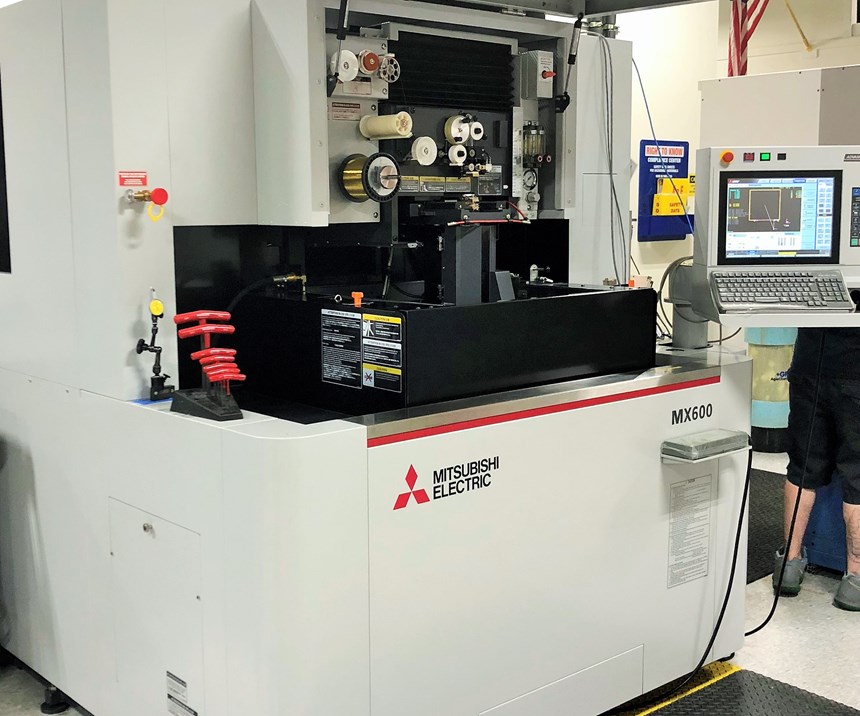High Precision Oil Wire EDM Exceeds Expectations
MTD Micro Molding, a micro molding medical component manufacturer, is the first company in North America to own an MC Machinery MX600 oil wire EDM and expand on how this machine has allowed the shop to work with small component sizes and increase productivity.
Founded in 1972, MTD Micro Molding (MTD) is not a typical micro molding medical component manufacturer, as it develops the world’s smallest components for the most challenging molding needs and the most innovative applications. To put it into perspective, 50 percent of MTD’s new projects are rescues, meaning projects no other molder would attempt due to their complexity or have attempted and failed.
The market for less-invasive micro medical devices continues to grow worldwide. In fact, the medical device industry leaps ahead almost daily, with constant demand for newer, smaller, never-before-seen micro devices. Because of the rapidly changing industry, MTD was in need of an EDM that had the capability to utilize wire smaller than 50-micron diameter. The company discovered that only two suppliers offered wire EDMs that met these cutting diameters, one being MC Machinery.
“We take on the challenging micro molding projects that are seemingly impossible to complete in the industry,” MTD Marketing Manager Lindsay Mann says. “In order to improve our process and ensure success, we need the right machinery and latest technology, such as the high-precision Mitsubishi MX600 oil wire EDM.”
The MX600 has been in the facility since April 2018. MTD is the first company in North America to own one. John Clark, operations manager at MTD, played a big role in the decision to purchase the machine. Having worked with Mitsubishi machines and the MC Machinery’s service team previously, he knew this was the right move.
What makes the MX600 oil wire EDM stand out is the use of oil as opposed to water. Oil allows the discharge gap to be much smaller than water, making it possible to achieve much smaller over-burns inside corners and provides a superior surface finish. Another benefit of the machine is the virtually zero recast on carbide after machining, and that it doesn’t corrode the material when left sitting in oil. When carbide is left in water, it leeches out the cobalt from the carbide, causing the material to fail in its application.
What makes the MX600 oil wire EDM stand out is the use of oil as opposed to water.
“The machine has doubled our wire EDM capacity and has made getting down to the smallest wire diameters much easier,” Clark says. “Although our lead time to build new tools is driven by the complexity of it and its components, on average, we were anywhere from six to eight weeks in production. Now, we can get components out to our customers in two to three weeks.”
Dependable and accurate equipment is essential when working with such small component sizes and micro features. MC Machinery also implemented the remote360 monitoring solution to the machine, which allows MTD to stay on top of production and send someone in if there is an issue. Additionally, the application is helping the company quote jobs by giving the team better visibility and records of the time it takes to complete similar work.
“The MX600 lets machining operators use ultra-small wire in the range of .0008" ~ .001",” Mike Bystrek, MC Machinery National Wire EDM Poduct and Applications Manager says. “This opens the doors and possibilities to the type of micromachining applications that can be developed.”
Related Content
Treatment and Disposal of Used Metalworking Fluids
With greater emphasis on fluid longevity and fluid recycling, it is important to remember that water-based metalworking fluids are “consumable” and have a finite life.
Read MoreMaintaining a Wire EDM Machine
To achieve the ultimate capability and level of productivity from your wire EDM on a consistent, repeatable and reliable basis, regular maintenance is a required task.
Read MoreThe Ins and Outs of Hot Runner Temperature Control
A training checklist that explains the why and how of proper hot runner temperature control and system management.
Read MoreFundamentals of Designing the Optimal Cooling System
The right mold components can help improve mold cooling and thereby produce higher-quality parts.
Read MoreRead Next
How to Use Strategic Planning Tools, Data to Manage the Human Side of Business
Q&A with Marion Wells, MMT EAB member and founder of Human Asset Management.
Read MoreHow to Use Continuing Education to Remain Competitive in Moldmaking
Continued training helps moldmakers make tooling decisions and properly use the latest cutting tool to efficiently machine high-quality molds.
Read MoreAre You a Moldmaker Considering 3D Printing? Consider the 3D Printing Workshop at NPE2024
Presentations will cover 3D printing for mold tooling, material innovation, product development, bridge production and full-scale, high-volume additive manufacturing.
Read More























